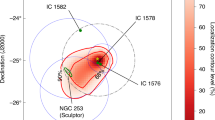Abstract
Based on the magnetar model, we have studied in detail the processes of neutrino cooling of an electron-positron plasma generating an SGR giant flare and the influence of the magnetar magnetic field on these processes. Electron-positron pair annihilation and synchrotron neutrino emission are shown to make a dominant contribution to the neutrino emissivity of such a plasma. We have calculated the neutrino energy losses from a plasma-filled region at the long tail stage of the SGR 0526-66, SGR 1806–20, and SGR 1900+14 giant flares. This plasma can emit the energy observed in an SGR giant flare only in the presence of a strongmagnetic field suppressing its neutrino energy losses. We have obtained a lower bound on the magnetic field strength and showed this value to be higher than the upper limit following from an estimate of the magnetic dipole losses for the magnetars being analyzed in a wide range of magnetar model parameters. Thus, it is problematic to explain the observed energy release at the long tail stage of an SGR giant flare in terms of the magnetarmodel.
Similar content being viewed by others
References
G. Beaudet, V. Petrosian, and E. E. Salpeter, Astrophys. J. 150, 979 (1967).
A. M. Beloborodov, Astrophys. J. 703, 1044 (2009).
A. M. Beloborodov and C. Thompson, Astrophys. J. 657, 967 (2007).
G. S. Bisnovatyi-Kogan, Fiz. Elem. Chastits At. Yadra 37, 1235 (2006) [Phys. Part. Nucl. 37, 647 (2006)].
R. Dib, V. M. Kaspi, F. P. Gavriil, et al., Astrophys. J. 673, 1044 (2008).
R. C. Duncan and C. Thompson, Astrophys. J. 392, L9 (1992).
D. D. Frederiks, S. V. Golenetskii, V. D. Pal’shin, et al., Pis’ma Astron. Zh. 33, 3 (2007) [Astron. Lett. 33, 1 (2007)].
E. Gogus, P. M. Woods, C. Kouveliotou, et al., Astrophys. J. 532, L121 (2000).
A. I. Ibragim, T. E. Strohmayer, P. M. Woods, et al., Astrophys. J. 558, 237 (2001).
N. Itoh, H. Hayashi, A. Nishikawa, et al., Astrophys. J. 102, 411 (1996).
A. D. Kaminker and D. G. Yakovlev, Zh. Eksp. Teor. Fiz. 103, 438 (1993) [J. Exp. Theor. Phys. 76, 229 (1993)].
A.D. Kaminker, O. Yu. Gnedin, D. G. Yakovlev, et al., Phys. Rev. D 46, 4133 (1992).
E. M. Kantor and M. E. Gusakov, Mon. Not. R. Astron. Soc. 381, 1702 (2007).
A. V. Kuznetsov, N. V. Mikheev, and L. A. Vassilevskaya, Phys. Lett. B 427, 105 (1998).
M. Lyutikov, Mon. Not. R. Astron. Soc. 367, 1594 (2006).
V. M. Malofeev, I. F. Malov, D. A. Teplych, et al., Astron. Rep. 49, 242 (2005).
I. F. Malov and G. Z. Machabeli, Astron. Astrophys. Trans. 25, 7 (2006).
E. P. Mazets, S. V. Golentskii, V. N. Ilinskii, et al., Nature 282, 587 (1979).
S. Mereghetti, Astron. Astrophys. 15, 225 (2008).
S. Mereghetti, D. Gotz, A. von Keinlin, et al., Astrophys. J. 624, L105 (2005).
D. A. Rumyantsev and M. V. Chistyakov, Zh. Eksp. Teor. Fiz. 134, 627 (2008) [J. Exp. Theor. Phys. 107, 533 (2008)].
T. E. Strohmayer and A. L. Watts, Astrophys. J. 653, 593 (2006).
C. Thompson and R. C. Duncan, Astrophys. J. 408, 194 (1993).
C. Thompson and R. C. Duncan, Mon. Not. R. Astron. Soc. 275, 255 (1995).
C. Thompson and R. C. Duncan, Astrophys. J. 473, 322 (1996).
C. Thompson and R. C. Duncan, Astrophys. J. 561, 980 (2001).
A. L. Watts and T. E. Strohmayer, Astrophys. Space Sci. 308, 625 (2007).
P. M. Woods, C. Kouveliotou, E. Gogus, et al., Astrophys. J. 629, 985 (2005).
D. G. Yakovlev, A. D. Kaminker, O. Y. Gnedin, and P. Haensel, Phys. Rep. 354, 1 (2001).
Author information
Authors and Affiliations
Corresponding author
Additional information
Original Russian Text © A.A. Gvozdev, I.S. Ognev, E.V. Osokina, 2011, published in Pis’ma v Astronomicheskiĭ Zhurnal, 2011, Vol. 37, No. 5, pp. 365–376.
Rights and permissions
About this article
Cite this article
Gvozdev, A.A., Ognev, I.S. & Osokina, E.V. Lower bound on the magnetic field strength of a magnetar from analysis of SGR giant flares. Astron. Lett. 37, 332–342 (2011). https://doi.org/10.1134/S1063773711040025
Received:
Published:
Issue Date:
DOI: https://doi.org/10.1134/S1063773711040025




